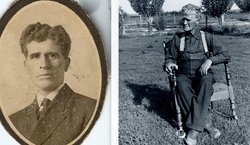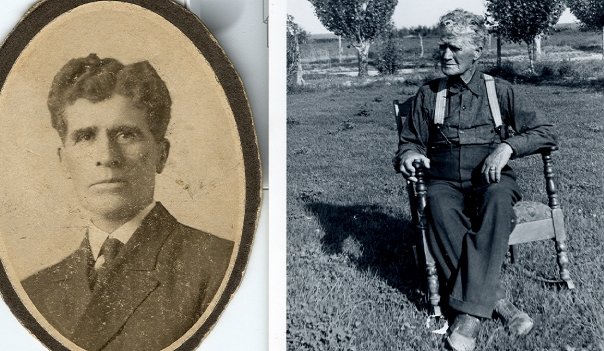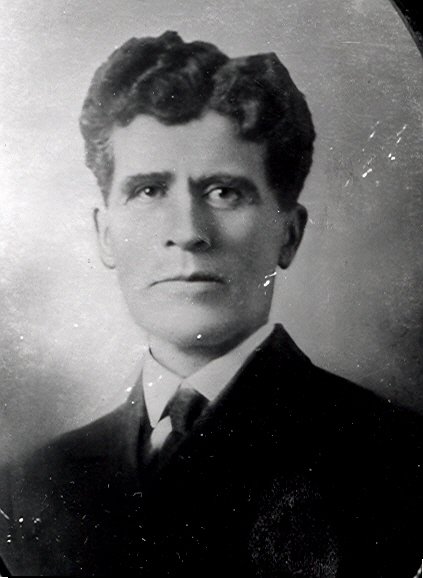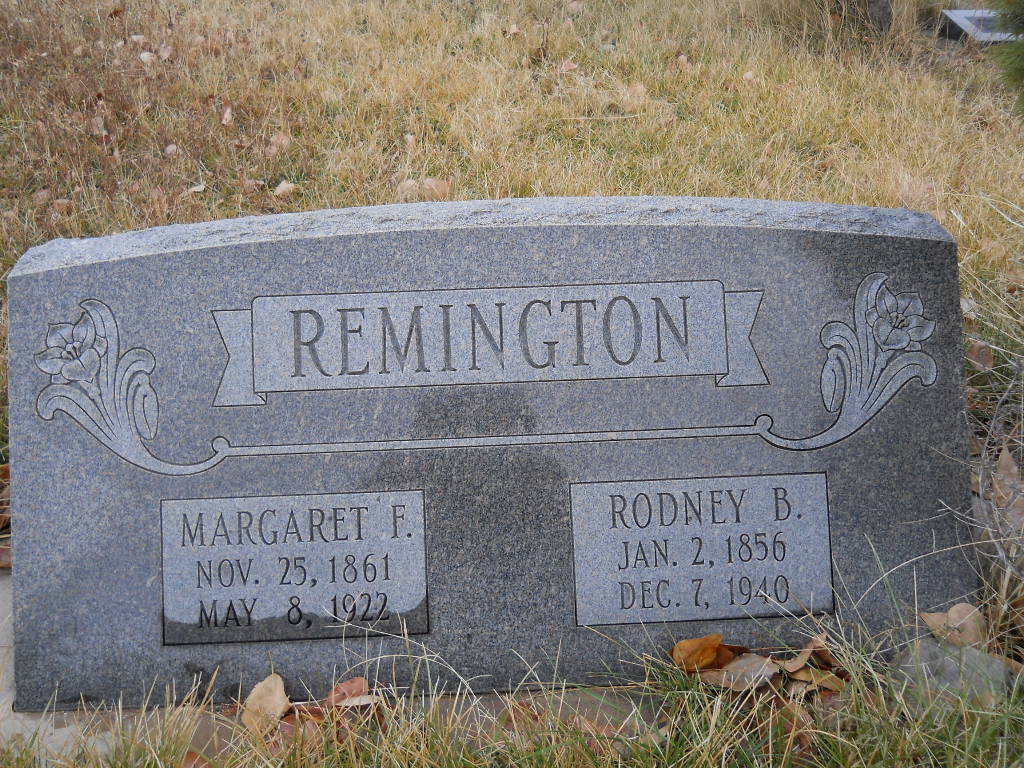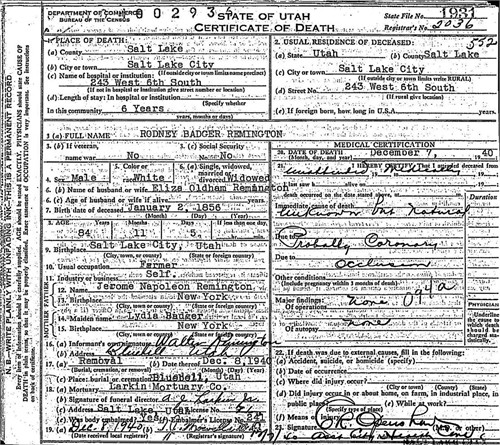Funeral services for R.B. Remington were held Monday in Bluebell with Bishop Bernard Winkler presiding. Speakers were A. G. Goodrich and Leslie Goodrich.
Mr. Remington died in Salt Lake Saturday. He had been doing temple work there until recently when he was taken to the hospital with pneumonia. After his condition improved he was returned to his home. At the time of his death he was sitting in his chair apparently asleep.
He was born January 2, 1855 and came to Ashley Valley in 1879 with his wife Eliza OldHan Remington and settle on White River. He has been a faithful church worker having held many responsible and prominent positions. For many years he was superintendent of the Sunday School. Approximately twenty-five years ago he made his home in Bluebell.
Surviving are four children. Mrs. Roxanna Harris and Rod Remington of Tabor, Alberta, Canada; Mrs. W. B. Reatross of Milton and Walter Remington of Bluebell.
He was the last survivor of his immediate family.
-Vernal Express, December 12, 1940, transcribed by Rhonda Holton
HISTORY OF NAPLES by Mrs. J. N. Lybberts, Reporter
The history of a community should not be merely interesting to us, but should lead to a fuller appreciation of the struggles and ideals of those hardy pioneers who laid the foundation for our present day opportunities and make us more determined to do our best and get the most out of our splendid inheritance.
In searching for early events one is impressed with the far-sightedness and energy of those first settlers, with their unity and communal spirit.
The first families to homestead in that part of the Ashley Valley which is now Naples were John Karren, William Hodgkinson, James Shafer, Porter Merrill, Mrs. Lydia Remington, Rodney Remington, William Perry, William Packard, McCurdy, Winfield Hullinger and Joseph H. Gardiner during or near the year 1882. Houses were soon built of native material. Porter Merrill's being about the first to have a board floor.
It should be remembered that the journey from the older settlements of Utah to Ashley Valley had been a hard one, in some instances taking several weeks to make it, and that on reaching here only a barren waste met the people's gaze. But it was remarkable how soon they turned their attention to building school houses and doing other public work.
At that time this ward was a part of Vernal then called "Ashley." As it was so far to go to Vernal to Sunday Schools, especially as slow ox teams were the usual means of travel, some of our people asked for an organization here. So on December 27, 1883, Bishop Hatch organized a Sunday School here with Porter Merrill as superintendent. These schools were held at home of Mrs. Lydia Remington and the text book used aside from the Bible were old school books. We have two members still in our ward who were in that first Sunday School, Mrs. Harriet Merrill, wife of the first superintendent and her sister Mrs. Marion Goodrich. Joseph H. Gardiner who is still with us, attended the second Sunday School held.
Mrs. Lydia Remington is one of the outstanding characters of our early history, although a widow, she was ever helpful and public spirited. She it was, who taught our first public school, which was held at her home. The text books used were some which she had foresight to bring from Cache Valley, showing her love for education. She was also a nurse of great ability, very much appreciated as there were no doctors in Ashley Valley yet.
In September 1884, Merrill Ward was organized and named for Porter Merrill who had died shortly before this. George A. Davis was appointed to act as bishop with Joseph H. Gardiner and William Perry as counselors and C. F. B. Lybbert as ward clerk. Mr. Lybbert held this position for nearly thirty years.
As all social and public enterprises centered around the church organization a list of those first officers may be of interest. The first Sunday School officers were Bradford Bird, superintendent; William H. Gagon (now of Roosevelt) and Arthur E. Gardiner, as counselors; Sarah Bird, president; Roxana Remington and Juliet Perry, counselors; (Roxana Remington was also the first stake Y.L.M.I.A. president), Relief Society officers were Lydia Remington, president; Sarah Bird and Juliet Perry, counselors; Young Men's Association: Arthur A. Gardiner, president; C. F. B. Lybbert and Rodney B. Remington, counselors.
The Young Ladies were not organized until 1887 when Elizabeth Davis was made president with Della McKowen and Almeda McCurdy as counselors.
District school was held at Mrs. Remington's home until 1886 when the "Old Log School House" was finished. This was at that time, the largest building in the valley and Stake conferences were held there for about a year until the first "Stake House" which is now Vernal First Ward Chapel was completed in 1887.
The Old Log School could tell many a tale of old time socials for it served for all purposes for several years. Our first brick school house was completed in 1900 and the second one on 1914.
In 1893 Ephraim Roberts built "Roberts Hall" where he made and sold all kinds of pottery for about a year, when the building was turned into an amusement hall.
In 1902 John Pope and others fixed it up for a store and post office for which it was used for several years when William Gillman built the "Naples store" which is now owned by the Ashley Co-op.
Our first post office was at the home of Alfred Powell, then later at Alma Bascom's until the store took over. But in 1906 the rural free delivery system was begun with Leon Pack as mail carrier. About two years later David L. Richards was transferred from our route where he still remains. In September 1894 a special mass meeting was called by Bishop James M. Shaffer and the following committee chosen to begin preparations for our ward meetinghouse: Rueben Collett, Sr., Jacob W. Olsen and James M. Shaffer. Later C. F. B. Lybbert, George A. Slaugh, John Karren, Bradford Bird and A. A. Haws were added to the committee. That fall actual work began and in 1899 the buildings were used for public gatherings.
Many big socials were held and the Relief Society sold suppers to help pay for the completion of the house. This undertaking was a big one for our small community but by united efforts of all a beautiful house was erected. The brick were made by our own members and even the small boys did all that was possible in making them and doing other hard work. Just to show the willingness of many, John Nielson, one of our stauch pionners did most of the excavating for the foundation of the ward house and all for the foundation and basement of the first brick school house. Masons, carpenters and many others did the same.
Through the enterprise of our people the electric lights were installed in the ward house and many homes in December 1912. For several years before this the ward house had been lighted by a gas plant.
The first telephone in Naples was put in William Gillman's store and the next one in the home of E. J. Longhurst.
Branches of the Merrill Ward Sunday School and meetings were held at "Pleasantville," now Davis Ward and "Riverdale" on Ashley Creek.
Other noteworthy work done by those early settlers is the building of our canals. When we think of the many things they accomplished, at first with ox teams and later with half-fed scrubby horses, we realize a little more our debt to them. Freighting was done over bad roads with poor wagons and horses, requiring weeks to make a trip to Price so very few luxuries were possible. The yearly visit of the "peddler" with his pocket knives, cloth or apples was a notable event.
C. F. B. Lybbert was the village blacksmith and he also had a mollasses mill. Candy pulls were famous pastimes. The most popular centers for such gatherings being at Merrill's or Lybbert's.
The homes of Joseph Remington, (Bishop Fuller Remington's father) and Bradford Bird were also social centers as they had big swings and Mr. Remington had a croquet court. Lybbert's also had a big swing; races, ball games, and other fine sports were enjoyed by young and old. In fact, one fine characteristic of those times is the sociability and friendly mingling of parents and young people in clean socials and games. Another great sport for the youngsters which we do not now have was playing on the "pummy" piles. This "pummy " was the dry sugar cane after the juice had been extracted for molasses.
Possibly these few items will help to recall many more to those of our older people who will read them and also speak a little of our appreciation for their work.
-Vernal Express, December 16, 1921, transcribed by Rhonda Holton
Rodney Badger Remington was the son of Lydia Ripley Badger and Jerome Napoleon Remington.
He married Eliza Oldham July 28, 1877 and after she died he married Margaret Francis Poague.
Funeral services for R.B. Remington were held Monday in Bluebell with Bishop Bernard Winkler presiding. Speakers were A. G. Goodrich and Leslie Goodrich.
Mr. Remington died in Salt Lake Saturday. He had been doing temple work there until recently when he was taken to the hospital with pneumonia. After his condition improved he was returned to his home. At the time of his death he was sitting in his chair apparently asleep.
He was born January 2, 1855 and came to Ashley Valley in 1879 with his wife Eliza OldHan Remington and settle on White River. He has been a faithful church worker having held many responsible and prominent positions. For many years he was superintendent of the Sunday School. Approximately twenty-five years ago he made his home in Bluebell.
Surviving are four children. Mrs. Roxanna Harris and Rod Remington of Tabor, Alberta, Canada; Mrs. W. B. Reatross of Milton and Walter Remington of Bluebell.
He was the last survivor of his immediate family.
-Vernal Express, December 12, 1940, transcribed by Rhonda Holton
HISTORY OF NAPLES by Mrs. J. N. Lybberts, Reporter
The history of a community should not be merely interesting to us, but should lead to a fuller appreciation of the struggles and ideals of those hardy pioneers who laid the foundation for our present day opportunities and make us more determined to do our best and get the most out of our splendid inheritance.
In searching for early events one is impressed with the far-sightedness and energy of those first settlers, with their unity and communal spirit.
The first families to homestead in that part of the Ashley Valley which is now Naples were John Karren, William Hodgkinson, James Shafer, Porter Merrill, Mrs. Lydia Remington, Rodney Remington, William Perry, William Packard, McCurdy, Winfield Hullinger and Joseph H. Gardiner during or near the year 1882. Houses were soon built of native material. Porter Merrill's being about the first to have a board floor.
It should be remembered that the journey from the older settlements of Utah to Ashley Valley had been a hard one, in some instances taking several weeks to make it, and that on reaching here only a barren waste met the people's gaze. But it was remarkable how soon they turned their attention to building school houses and doing other public work.
At that time this ward was a part of Vernal then called "Ashley." As it was so far to go to Vernal to Sunday Schools, especially as slow ox teams were the usual means of travel, some of our people asked for an organization here. So on December 27, 1883, Bishop Hatch organized a Sunday School here with Porter Merrill as superintendent. These schools were held at home of Mrs. Lydia Remington and the text book used aside from the Bible were old school books. We have two members still in our ward who were in that first Sunday School, Mrs. Harriet Merrill, wife of the first superintendent and her sister Mrs. Marion Goodrich. Joseph H. Gardiner who is still with us, attended the second Sunday School held.
Mrs. Lydia Remington is one of the outstanding characters of our early history, although a widow, she was ever helpful and public spirited. She it was, who taught our first public school, which was held at her home. The text books used were some which she had foresight to bring from Cache Valley, showing her love for education. She was also a nurse of great ability, very much appreciated as there were no doctors in Ashley Valley yet.
In September 1884, Merrill Ward was organized and named for Porter Merrill who had died shortly before this. George A. Davis was appointed to act as bishop with Joseph H. Gardiner and William Perry as counselors and C. F. B. Lybbert as ward clerk. Mr. Lybbert held this position for nearly thirty years.
As all social and public enterprises centered around the church organization a list of those first officers may be of interest. The first Sunday School officers were Bradford Bird, superintendent; William H. Gagon (now of Roosevelt) and Arthur E. Gardiner, as counselors; Sarah Bird, president; Roxana Remington and Juliet Perry, counselors; (Roxana Remington was also the first stake Y.L.M.I.A. president), Relief Society officers were Lydia Remington, president; Sarah Bird and Juliet Perry, counselors; Young Men's Association: Arthur A. Gardiner, president; C. F. B. Lybbert and Rodney B. Remington, counselors.
The Young Ladies were not organized until 1887 when Elizabeth Davis was made president with Della McKowen and Almeda McCurdy as counselors.
District school was held at Mrs. Remington's home until 1886 when the "Old Log School House" was finished. This was at that time, the largest building in the valley and Stake conferences were held there for about a year until the first "Stake House" which is now Vernal First Ward Chapel was completed in 1887.
The Old Log School could tell many a tale of old time socials for it served for all purposes for several years. Our first brick school house was completed in 1900 and the second one on 1914.
In 1893 Ephraim Roberts built "Roberts Hall" where he made and sold all kinds of pottery for about a year, when the building was turned into an amusement hall.
In 1902 John Pope and others fixed it up for a store and post office for which it was used for several years when William Gillman built the "Naples store" which is now owned by the Ashley Co-op.
Our first post office was at the home of Alfred Powell, then later at Alma Bascom's until the store took over. But in 1906 the rural free delivery system was begun with Leon Pack as mail carrier. About two years later David L. Richards was transferred from our route where he still remains. In September 1894 a special mass meeting was called by Bishop James M. Shaffer and the following committee chosen to begin preparations for our ward meetinghouse: Rueben Collett, Sr., Jacob W. Olsen and James M. Shaffer. Later C. F. B. Lybbert, George A. Slaugh, John Karren, Bradford Bird and A. A. Haws were added to the committee. That fall actual work began and in 1899 the buildings were used for public gatherings.
Many big socials were held and the Relief Society sold suppers to help pay for the completion of the house. This undertaking was a big one for our small community but by united efforts of all a beautiful house was erected. The brick were made by our own members and even the small boys did all that was possible in making them and doing other hard work. Just to show the willingness of many, John Nielson, one of our stauch pionners did most of the excavating for the foundation of the ward house and all for the foundation and basement of the first brick school house. Masons, carpenters and many others did the same.
Through the enterprise of our people the electric lights were installed in the ward house and many homes in December 1912. For several years before this the ward house had been lighted by a gas plant.
The first telephone in Naples was put in William Gillman's store and the next one in the home of E. J. Longhurst.
Branches of the Merrill Ward Sunday School and meetings were held at "Pleasantville," now Davis Ward and "Riverdale" on Ashley Creek.
Other noteworthy work done by those early settlers is the building of our canals. When we think of the many things they accomplished, at first with ox teams and later with half-fed scrubby horses, we realize a little more our debt to them. Freighting was done over bad roads with poor wagons and horses, requiring weeks to make a trip to Price so very few luxuries were possible. The yearly visit of the "peddler" with his pocket knives, cloth or apples was a notable event.
C. F. B. Lybbert was the village blacksmith and he also had a mollasses mill. Candy pulls were famous pastimes. The most popular centers for such gatherings being at Merrill's or Lybbert's.
The homes of Joseph Remington, (Bishop Fuller Remington's father) and Bradford Bird were also social centers as they had big swings and Mr. Remington had a croquet court. Lybbert's also had a big swing; races, ball games, and other fine sports were enjoyed by young and old. In fact, one fine characteristic of those times is the sociability and friendly mingling of parents and young people in clean socials and games. Another great sport for the youngsters which we do not now have was playing on the "pummy" piles. This "pummy " was the dry sugar cane after the juice had been extracted for molasses.
Possibly these few items will help to recall many more to those of our older people who will read them and also speak a little of our appreciation for their work.
-Vernal Express, December 16, 1921, transcribed by Rhonda Holton
Rodney Badger Remington was the son of Lydia Ripley Badger and Jerome Napoleon Remington.
He married Eliza Oldham July 28, 1877 and after she died he married Margaret Francis Poague.
Family Members
-
![]()
Rodney O. Remington
1878–1950
-
![]()
Eliza Oldham Remington Perry
1880–1939
-
![]()
John Bradley Oldham Remington
1882–1883
-
![]()
Frank Oldham Remington
1884–1889
-
![]()
Maria Oldham Remington Holdaway
1886–1934
-
![]()
Royal Oldham Remington
1888–1889
-
![]()
Lydia Oldham Remington Peatross
1890–1974
-
![]()
Roxana Oldham Remington Harris
1894–1974
-
![]()
Walter Poage Remington
1907–1976
Sponsored by Ancestry
Advertisement
Advertisement
